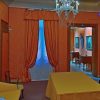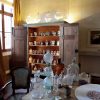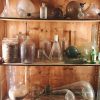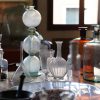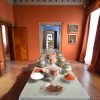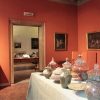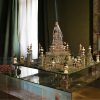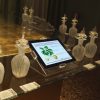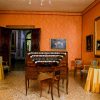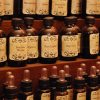
Strongly supported by Mavive SpA, a Venetian company of Vidal’s family – main partner of a real act of patronage designed to reaffirm the deep bond with the city of Venice – the new section dedicated to fragrances enrich the exhibition on the first floor of the Museum of Palazzo Mocenigo at San Stae. In the five rooms that are dedicated to perfume and are perfectly integrated with the attraction of the displays throughout the museum, multi-media instruments and experiences using the senses alternate along an itinerary of information, emotion and closer study.
Room 13
This room leads to the section dedicated to a lesser known but very special and intriguing aspect of Venetian life, that relating to the history of perfume.
A video evocatively recounts the history of the sector since the Middle Ages, along with the secrets of production, the whims of customers and the evolution of taste, clearly underlining how fundamental the contribution of Venice has been to this art.
The apogee of this story unfolded in the sixteenth century, when perfume was all the rage. Among the most picturesque items being made at the time were paternostri, or rosaries made of perfumed paste; moscardini, which were tablets to combat bad breath; uccelletti di Cipro, or fragrant pastes, perhaps in the shape of birds, that could be burned like incense; the lisci and manteche, which included various cosmetic preparations; acqua nanfa, which was a distillate of orange blossoms; and the bionde, or solutions for bleaching Venetian women’s hair.
Leather gloves treated to smother the unpleasant smell of tanning were also famous, although a devious, poison-soaked version of them is also recorded as an all-Italian speciality.
Room 14
The room evokes the atmosphere of a workshop of a perfumer, once known as a muschiere or ‘musk-maker’; a repository of processes and recipes for creating soaps, oils, pastes, powders and liquids to perfume rooms, bodies, clothes and accessories.
From the last decades of the fifteenth century, a new interest in women’s cosmetics developed in Italy and numerous recipe books and treatises based on the medieval texts were printed, especially in Venice. These books still consisted of heterogeneous blends of medicine and cosmetics, art and science, pharmacopoeia and magic. The Notandissimi secreti dell’arte profumatoria by the Venetian Giovanventura Rossetti, author also of the Plichto on the art of dyeing, is considered to be the first real treatise on perfumery. It was published posthumously in Venice in 1555 but written before 1549.
In this room, littered with alembics, various containers and apothecary albarello vases, a Venetian edition from 1570 of Commentarii in sex libros Pedacij Dioscoridis Anazarbei de Medica materia […] dominates the table. The work of Pietro Andrea Mattioli (1501-1578), it is the best-known botanical and pharmaceutical text of the sixteenth century, and contains commentaries on the medical work of Dioscorides Pedacius, along with popular notions and the medicinal virtues of hundreds of plants that were unpublished at the time.
The wall panel is an olfactory map tracing the routes travelled by Venetian merchants to procure raw materials through the dense trading networks of the maritime convoys set up by the Venetian state, known as mude. These routes were fundamental for trade and for making Venice one of the capitals of perfumery in the West.
Room 15
This room is dedicated to the raw materials used in perfume production, most of which were already mentioned in ancient Renaissance recipe books.
Expensive and sought-after, perfumes required rare and exotic raw materials, both of plant origin such as benzoin or cinnamon, and animal origin such as civet and castoreum.
Some were particularly rare: musk, or moscado, for example, a secretion from a hairy pouch near the navel of male specimens of the moschus moschiferus, a mammal belonging to the deer family. Another was ambergris, ambracan, obtained from the intestinal concretions of sperm whales and other cetaceans.
In the two showcases, a selection of antique Venetian glassware is displayed on one side; on the other, among dried plant materials, are the Secreti nobilissimi dell’arte profumatoria, in the 1672 Bolognese reprint of Rossetti’s work, and the Secreti del reverendo don Alessio piemontese, a Venetian reissue of 1783, much later than the first edition of 1555, both belonging to the Vidal Collection.
The wall paintings, all of small format, represent themes dear to the repertoire of anecdotal and confidential subjects characteristic of the famous Venetian painter Pietro Longhi. Some of them are explicit eighteenth-century replicas, while others are tackled with a more autonomous pictorial rendering.
Room 16
Three showcases, three centuries, three ways of experiencing and interpreting perfume and its containers in cultural, aesthetic and social terms.
The selection exhibited here is on loan from the Storp Collection in Munich.
Showcase 1: the refined splendour of the eighteenth century
In the eighteenth century, perfume was still reserved for a select few, an elite thanks to their title and social position.
The bottles are small and precious and contain limited quantities of fragrant balm or highly concentrated fragrances. These were created from precious or exotic materials that a skilled craftsman/artist shaped, infusing them with mastery and imagination, often following the wishes and whims of the customer who would display them as a symbol of wealth and refinement. Often, these containers were worn as real jewellery.
In addition to the usual gold and silver, we find tortoiseshell, mother-of-pearl, semi-precious stones, glass and above all porcelain, a recent European technological breakthrough, made into the most varied forms.
The classic models of the statuettes produced by the great manufactures of Meissen, Chelsea, Capodimonte and Sèvres, to name the most famous, became small perfume containers known to collectors by the curious name of Girl-in-a-swing, taken from an English figurine made by Charles Gouyn around 1750, depicting a girl on a swing.
Showcase 2: the solid transparencies of the nineteenth century
The rise of the bourgeoisie greatly increased the number of those using perfume as a finishing touch for their improved personal hygiene.
The nineteenth century was the century of Eau de Cologne filling large, often faceted, coloured glass bottles placed on dressing room shelves along with other cosmetic articles.
Europe and the United States competed to offer increasingly showy and important bottles, decorated in gold, with sinuous shapes and opaline or thick crystal glass.
Bohemia led the movement that competed with Murano, which suffered a profound crisis, along with newcomers such as the United States, which sought to satisfy the domestic market.
Glass masters travelled, and with them techniques and styles, to the point that it becomes difficult, sometimes impossible, to make a definite attribution, so similar are the models.
In the case of small bottles, their metal caps can provide a few more clues, while in the case of purely glass containers, almost always without brand names, only a few decorations or particular shapes provide some clues.
Showcase 3: the unique style of the twentieth century
In the twentieth century, perfume was on its way to becoming a mass product. How then to create an elitist product?
The answer lay in a mixture giving rise to the most iconic perfumes of all time, combinations of an exclusive fashion name, a famous glass designer and a great nose, namely, the perfume creator responsible for inventing perfect accords of essences. During this century, these were grouped into olfactory families, of which Fougère and Chypre are two, giving rise to highly successful perfumes.
One name above all symbolises glass design at the turn of the century: René Lalique.
With him, the commercial perfume bottle, one with a specific brand name, became a luxury object, a recognisable symbol of a perfume manufactory, but also of a refined and precious style.
His bottles or those of other designers, such as Depinoix and Viard, are today the object of desire of many collectors, and are considered as timeless artistic objects that have retained their charm.
Room 17
The term olfactory family indicates the modern classification of perfumes based on the elements of which they are composed. On the table, contained in eighteen glass bottles made by hand by Venetian craftsmen, the essences that contribute to the formation of six of the seven main official families are available for the public to sniff.
Visitors can lift the caps to experience the fragrances in an intoxicating way while gleaning useful and interesting scientific information from the associated panels.
The bottles are arranged around a refined eighteenth-century Venetian glass and crystal deser, a precious and triumphant decoration created to enrich the table and impress guests at sumptuous banquets, or as gifts to foreign kings and princes.
The decoration of the room is completed by a pair of imposing nineteenth-century mirrors bearing the symbol of the island of Murano engraved at the top of the frame, together with a painting depicting a carnival scene in St. Mark’s Square in Venice, which is particularly interesting for the multicoloured costumes and bizarre masks depicted, the forerunners of the eighteenth-century bauta outfit that is seen very frequently in Pietro Longhi’s artistic production.
Rooms 18 and 19
The protagonist of room 18 is the ancient and rare organo da profumiere – literally an ‘organ for perfumers’ – an extraordinary and peculiar piece of furniture used by a master perfumer to compose his creations from over two hundred bottles of essential oils, here lined up like spectators seated on the cavea of an antique theatre. On the walls, together with the curious and bizarre portrait of a tiny pet dog, there are portraits of women; thanks to their different hairstyles and more or less dishevelled clothing, they testify to some of the variations in the fickle fashions to be seen the turn of the seventeenth and eighteenth centuries. Room 19 is set up as a small gallery of Old Master paintings, with genre or sacred scenes, plus a small portrait of a Venetian lady from the late Renaissance, recognisable and datable by the characteristic and eccentric hairstyle of ringed and wavy locks, as well as by the conspicuous neckline of her dress.
Download
MUSEUM OF PALAZZO MOCENIGO
Information Cards
![]() – Italiano >
– Italiano >
– English >
– Français >
_
MUSEUM OF PALAZZO MOCENIGO
Clothes and textiles
Clothes and textiles on display in the Museum from the collections of the Study Centre for the History of Textiles and Costume at Palazzo Mocenigo
![]() – Italiano >
– Italiano >
– English >
– Français >
